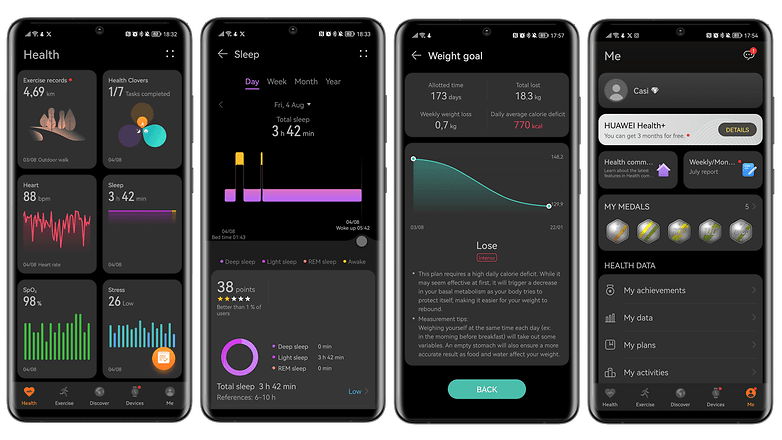Xiaomi Smart Band 8 vs Huawei Band 8: Which Reigns Supreme?


Huawei already released its fitness tracker Huawei Band 8 globally, with its closest competitor, the Xiaomi Smart Band 8, also available for purchase in China. nextpit compared both models and reveal the similarities and differences between these two smart wristbands.
Xiaomi Smart Band 8 and Huawei Band 8: Specifications Compared
| Xiaomi's latest model | Huawei's latest model | |
|---|---|---|
| Device | ||
| Image |

|

|
| Display | 1.62″ AMOLED, 192 x 490 pixels (326 ppi), 600 nits | 1.47" AMOLED, 194 x 368 pixels (283 ppi), 500 nits |
| Dimensions | 48 x 22.5 x 10.99 mm | 43.45 x 24.54 x 8.99 mm |
| Weight | 27 g with wristband | 14 g without wristband |
| Water resistance | 5 ATM | 5 ATM |
| Connectivity | Bluetooth 5.1, no GPS, no NFC | Bluetooth 5.0, no GPS, no NFC |
| Battery | 190 mAh, 16 days battery life | 180 mAh, 14 days battery life |
| Features | 150 sport modes, measures SPO2 and heart rate, sleep tracker etc. | 100 sports modes, measures SPO2 and heart rate, sleep tracker and more |
| Pros |
|
|
| Cons |
|
|
| Rating |
|
|
| To the offer* |
|
Both devices already made an appearance in the nextpit editorial team. However, while I was able to review the global version of the Huawei Band 8, while Matt had a sneak peek at the Chinese version of the Xiaomi Smart Band 8. This is why we have not yet settled on a final rating and a score for this model. Do be patient until the global wristband is released for us to get a better idea of what Xiaomi's offering is capable of.
Nevertheless, we think that you can already get a good overview of the two fitness trackers in our comparison. Let's get started!
Table of Contents:
Hardware, design, display
Visually, nothing much has changed, that much I can say. The dimensions have changed minimally for both and the Huawei Band 8 lost two grams of weight (14 g without wristband). Comparisons are made all the more difficult because Xiaomi has now decided to only mention the weight with the wristband included (27 g).
Display sizes remain identical as with their respective predecessors. This means the Xiaomi Smart Band 8 is larger at 1.62" than the 1.47" panel found in the Huawei Band 8. Both displays are also protected by 2.5D glass.
With a resolution of 192 x 490 pixels, Xiaomi crept in front of its competitor here, as the latter only managed 194 x 368 pixels, resulting in a lower pixel density. With the higher brightness count (600 vs 500 nits), Xiaomi thus secured the necessary points required for victory in the display category. Speaking of brightness: It is now automatically controlled in the Smart Band 8, whereas Huawei is still waiting for an ambient light sensor.

Thus, all that remains to be said about the hardware is that both plastic fitness trackers can still withstand splashes of water (5 ATM) based on certain conditions, and both actually come with new chassis.
Previously, you simply stuffed the body of the Xiaomi tracker into the silicone wristband, but from 8th generation onward, there are neat receptacles into which you can click the wristband. This also boasts the advantage of letting you use other accessories, including wearing the Smart Band 8 around the neck or even on your trainers.
Huawei also relies on a new mechanism that makes it easy to insert or remove wristbands. However, this only works with Huawei-branded bands, not with those from third-party suppliers.
One more word about hardware and connectivity: Both Xiaomi and Huawei still do not offer NFC, at least internationally. You will also search for GPS in vain, which I consider to be a serious omission for both manufacturers. Please give us these features in the next generation.
Sensors and range of functions
Xiaomi really stepped up its game when it comes to sports modes: From 30 modes in the Mi Band 6 to 120 modes in the Smart Band 7 and now, 150 sports modes in the Smart Band 8. Hats off to Xiaomi for increasing its functionality. Huawei also offers improvements, but "only" sees an increase from 96 to 100 modes. We should probably not overestimate that since the most important disciplines have long been available.
Sleep tracking, blood oxygen level (SpO2) measurement, heart rate monitoring, and of course, a pedometer—both devices are still capable of all that, and there was nothing new added in this respect. However, I personally noticed that Huawei's sleep tracking via TruSleep technology is often dramatically inaccurate in the Huawei Band 8.

In general, you should bear in mind, especially concerning the health features, that the determined values are at best indications and cannot be a replacement for the readings and measurements performed by medical professionals or doctors. However, Xiaomi has at least improved the accuracy of its step tracking here.
- Also read: These are the best fitness trackers in 2023
Thanks to the new wristband mechanism mentioned earlier, you can also attach the Xiaomi fitness tracker to your sneakers via separately sold accessories. According to Xiaomi, this increases the reliability when tracking steps by about five percent.
Otherwise, unfortunately, very little has changed on both models. This also means that you have to make do with the touch display for navigation in Xiaomi's case, while Huawei additionally offers you a hardware button. To be honest, I found both operating modes very intuitive and I think you will get used to both effortlessly.
Battery
Once again, Xiaomi made some strides here. While the Huawei Band 8's battery remains at 180 mAh, the Xiaomi battery has grown from 180 to 190 mAh and is now supposed to last up to 16 days. Huawei, however, stated that the battery will run out after 14 days at the most.
However, both values are theoretical laboratory values that you will not be able to eke out in real life with all the necessary features enabled. However, 5 to 6 days of battery life were easily achievable in my review with above-average usage patterns.

We prefer to wait until we can review the European version of Xiaomi's device before we are able to provide a definitive conclusion about its battery life. However, it is highly recommended you deactivate the always-on displays on both trackers. First, this is because no display needs to be constantly turned on, and second, this places a lot of drain on the battery life.
What else can be said about the batteries? The Xiaomi Smart Band 8 can be fully charged in about an hour. Huawei was much slower here last year, but now managed the feat of a fully charged battery from empty after just 45 minutes. This is one of the few significant improvements from the Huawei camp this year.
Price and availability
Price and availability? This is a difficult category to judge because the global Xiaomi Smart Band 8 model is still unavailable. Trading Shenzhen currently priced it at $74.21 if you want to have the device shipped from China. However, that is not necessarily an indication of the official market price.
Huawei, on the other hand, officially listed the recommended retail price at €59. After all, with the Huawei embargo Stateside, you will never find it available officially in the US. You are welcome to check out other online sites and see whether you can pick it up for cheaper.
The question for Xiaomi might be: which model is more likely to be released the global version of the Smart Band 8 or the China-bound Smart Band 8 Pro? My cautious guess would be the latter.
Conclusion
Let's arrive at the conclusion, where the winner just limped over by a whisker. I mentioned "limped over" because officially, we don't know anything about the availability of the Xiaomi Smart Band 8 outside of China. We can only speculate that the device will be similarly specced to the Chinese model.
Assuming that nothing has changed functionally, I feel that Xiaomi has made more progress than Huawei: There are significantly more sports modes, a brighter, faster display, and a longer battery life. All these are factors that point toward moderate progress.
Huawei, on the other hand, is noticeably more relaxed about its fitness tracker. They also offer a new wristband mechanism and included automatic adaptive brightness, without any innovation otherwise. No, the Band 8 (by the way, every time I read/write about Band 8 here is pretty lame in terms of innovations.
It might be that Huawei's most important argument could be the price but then again, we will have to wait and see what Xiaomi charges for its device!
If you were to ask me, no one who owns one of either predecessor models has to buy this. There is simply not enough new developments to drop money for the latest model. However, you can safely buy both of them knowing that you have purchased a very decent fitness tracker.
I found the lack of GPS and especially NFC to be even more dramatic omissions with each passing year. For this reason alone, I'm already secretly waiting for the ninth generation of these two fitness trackers.
What do you think? Do you have a clear favorite between the two? Do you regret the poverty of new features as much as I do or is the inexpensive fitness tracker already so complete that no major innovations are needed? Please have no hesitation to write us in the comments.













